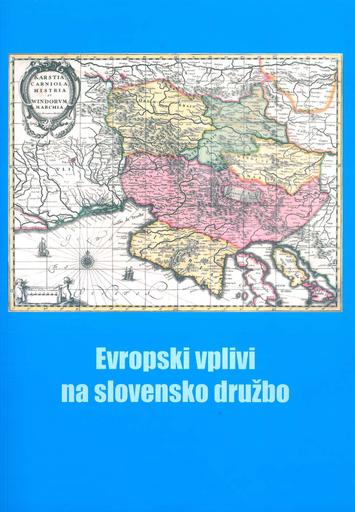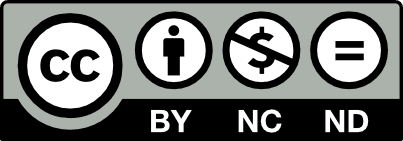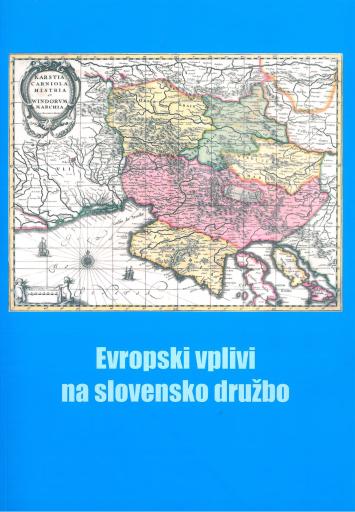/
Literatura
/
Monografije
Judje s Spodnje Štajerske in Gorenjske kot žrtve holokavsta v Evropi

Avtor(ji):Andrej Pančur
Soavtor(ji):Nevenka Troha (ur.), Mojca Šorn (ur.), Bojan Balkovec (ur.)
Leto:2008
Založnik(i):Zveza zgodovinskih društev Slovenije, Ljubljana
Jezik(i):slovenščina
Vrst(e) gradiva:besedilo
Ključne besede:Spodnja Štajerska, Gorenjska, Jugoslavija, druga svetovna vojna, Judje, holokavst, nacizem, begunci, izgnanci, Lower Styria, Upper Carniola, Yugoslavia, Second World War, Jews, the Holocaust, Nazism, refugees, exiles
Zbirk(e):Zbirka zgodovinskega časopisa ; 35
Avtorske pravice:

To delo avtorja Andrej Pančur je ponujeno pod Creative Commons Priznanje avtorstva-Nekomercialno-Brez predelav 4.0 Mednarodna
Datoteke (1)

Ime:evropski_vplivi_na_slovensko_druzbo.pdf
Velikost:185.05MB
Format:application/pdf
Stalna povezava:https://hdl.handle.net/11686/file18570
Opis
Zgodovina holokavsta izkazuje velike regionalne razlike, katere pridejo jasno do izraza šele z umestitvijo v širši evropski kontekst. Na kasnejšem nemškem okupacijskem območju Spodnje Štajerske (Untersteiermark) in Gorenjske (Besetzte Gebiete Karntens und Krains) je pred vojno živelo relativno malo Judov, med katerimi jih je veliko izviralo iz srednjeevropskih držav, kjer so bili Judje že podvrženi različnim oblikam preganjanja. Aprila 1941 se je z okupacijo to preganjanje razširilo še na tiste, ki pred okupatorjem niso pobegnili na varno. Sprva so jih preganjali skupaj z rasno in politično nezaželenimi Slovenci (odvzem državljanstva, zaplemba premoženja, izgon v Srbijo in na Hrvaško). Šele 1. aprila 1942 so na Spodnjem Štajerskem začeli veljati nürnberški rasni zakoni, na Gorenjskem pa ti zakoni sploh nikoli niso bili uveljavljeni. Toda takrat tam praktično ni bilo več Judov, nad katerimi bi okupator izvajal holokavst, temveč so ti Judje postali žrtve holokavsta v drugih evropskih deželah.
Metapodatki (13)
- identifikatorhttps://hdl.handle.net/11686/35303
- naslov
- Judje s Spodnje Štajerske in Gorenjske kot žrtve holokavsta v Evropi
- Jews of Lower Styria and Upper Carniola as Holocaust Victims in Europe
- avtor
- Andrej Pančur
- soavtor
- Nevenka Troha (ur.)
- Mojca Šorn (ur.)
- Bojan Balkovec (ur.)
- predmet
- Spodnja Štajerska
- Gorenjska
- Jugoslavija
- druga svetovna vojna
- Judje
- holokavst
- nacizem
- begunci
- izgnanci
- Lower Styria
- Upper Carniola
- Yugoslavia
- Second World War
- Jews
- the Holocaust
- Nazism
- refugees
- exiles
- opis
- The history of the Holocaust shows great regional différences, which only become clear when they are placed within a wider European context. The exclusion of Jews from society, the deprivation of civil and human rights, their expropriation, exile or déportation and their slavery are those stages of Jew persécution which eventually led to the systematic murder of Jews in Nazi Europe. At a local level these general stages were carried out in an entirely different time and content; in Germany gradually ever since 1933, and elsewhere more or less quickly by adopting local anti-Jew législation, spreading German influence and/or by German occupation. In the territories of Lower Styria and Upper Camiola, later occupied by Germany, very few Jews resided before the war (some 250). They were mostly immigrants from thè middle and upper classes. Among these there was a relatively high number of immigrants with foreign citizenship. Many originated from Central European countries, where they had already been subjected to various types o f persécution due to the spread of Nazi authority (Germany, Austria, Czechoslovakia). The Jews from these countries, which had been living in Yugoslavia for some time, applied for Yugoslav citizenship, while at the same time, more and more Jewish refugees entered thè country. The Yugoslav national authorities consequently exercised an increasingly restrictive policy towards Jewish refugees and citizenship applicants, and eventually accepted two anti-Jewish decrees in October 1940. The genuine persécution of the Jewish population in Lower Styria and Upper Camiola began after the defeat of Yugoslavia in the April war of 1941, when Germany occupied both provinces. That was why most Jews immediately fled to safety in the direction of Italy. Since there were only so few Jews left, they were at first persecuted together with racially and politically unwanted Slovenians (citizenship deprivation, confiscation of property, exile into Serbia or Croatia). It was only on Ist April, 1942 that the Nurenberg race laws came into effect in Lower Styria, while these laws were never passed in Upper Camiola. However, at that time there were practically no Jews left in this région for the occupier to lead to their deaths at the concentration camps. In this regard, the Holocaust in Lower Styria and Upper Camiola was carried out quite differently as elsewhere in German Europe, where the Jewish population was persecuted separately and far more radically than other groups of unwanted population. After the second half of 1941, when the Holocaust of the occupied East began to spread over the remaining European Jews, Lower Styria and Upper Camiola were already »free of Jews«. The Jewish refugees and exiles thus suffered the Holocaust in other European countries, particularly in Italy, Serbia, Croatia and Hungary. Among the mass of the remaining refugees and exiles, a great deal outlasted the battle against time, yet there were quite a few that had not survived the Holocaust.
- Zgodovina holokavsta izkazuje velike regionalne razlike, katere pridejo jasno do izraza šele z umestitvijo v širši evropski kontekst. Na kasnejšem nemškem okupacijskem območju Spodnje Štajerske (Untersteiermark) in Gorenjske (Besetzte Gebiete Karntens und Krains) je pred vojno živelo relativno malo Judov, med katerimi jih je veliko izviralo iz srednjeevropskih držav, kjer so bili Judje že podvrženi različnim oblikam preganjanja. Aprila 1941 se je z okupacijo to preganjanje razširilo še na tiste, ki pred okupatorjem niso pobegnili na varno. Sprva so jih preganjali skupaj z rasno in politično nezaželenimi Slovenci (odvzem državljanstva, zaplemba premoženja, izgon v Srbijo in na Hrvaško). Šele 1. aprila 1942 so na Spodnjem Štajerskem začeli veljati nürnberški rasni zakoni, na Gorenjskem pa ti zakoni sploh nikoli niso bili uveljavljeni. Toda takrat tam praktično ni bilo več Judov, nad katerimi bi okupator izvajal holokavst, temveč so ti Judje postali žrtve holokavsta v drugih evropskih deželah.
- založnik
- Zveza zgodovinskih društev Slovenije
- zbirka
- Zbirka zgodovinskega časopisa ; 35
- datum
- 2008
- tip
- besedilo
- jezik
- Slovenščina
- jeDelOd
- pravice
- licenca: ccByNcNd
Citirano v (2)
| Tipologija | Avtor(ji) | Naslov | Kraj | Založba | Leto |
|---|---|---|---|---|---|
| 1.16 Uvodnik, predgovor, spremna beseda | Pančur, Andrej | History of the holocaust in Slovenia | Ljubljana | Inštitut za novejšo zgodovino = Institute of Contemporary History | 2016 |
| 1.01 Izvirni znanstveni članek | Pančur, Andrej | Migracije judovskega prebivalstva na Slovenskem od judovske emancipacije do holokavsta | Ljubljana | 2010 |
Seznam literature v delu (42)
| Stran | Avtor | Naslov | Vir | Kraj | Založba | Leto |
|---|---|---|---|---|---|---|
| 367 | Wehler Hans, Urlich | Deutsche Gesellschaftsgeschichte, 4. del. | München | 2003 | ||
| 368 | Oprach, Marc | Nationalsozialistische Judenpolitik im Protektorat Böhmen und Mähren | Hamburg | 2006 | ||
| 368 | Longerich, Peter | Tendenzen und Perspektiven der Taterforschung | Aus Politik und Zeitgeschichte | 2007 | ||
| 368 | Ferenc, Tone | Okupacijski sistemi med drugo svetovno vojno, 1. del. | Ljubljana | 2006 | ||
| 368 | Ferenc, Tone | Okupacija slovenskega ozemlja | Slovenska novejša zgodovina 1848-1992 | Ljubljana | 2006 | |
| 368 | Ferenc, Tone | Nacistična raznarodovalna politika v Sloveniji v letih 1941-1945 | Maribor | 1968 | ||
| 368 | Pančur, Andrej | Teritorialni obseg judovskih verskih občin na ozemlju sedanje Slovenije pred drugo svetovno vojno | Prispevki za novejšo zgodovino | 2008 | ||
| 370 | Potočnik, Drago | Statistični dodatek | Spominski zbornik Slovenije | Ljubljana | 1939 | |
| 370 | Lichtblau, Albert | Integration, Vernichtungsversuch und Neubeginn - Österreichisch-jüdische Geschichte 1848 bis zur Gegenwart | Geschichte der Juden in Österreich | Wien | 2006 | |
| 371 | Barkai, Avraham | Jüdisches Leben unter der Verfolgung | Deutsch-jüdische Geschichte in der Neuzeit, 4. del. | München | 2000 | |
| 371 | Goldstein, Ivo | Židovi u Zagrebu | Zagreb | 2004 | ||
| 371 | Osterloh, Jörg | Nationalsozialistische Judenverfolgung im Reichsgau Sudetenland 1938-1945 | München | 2006 | ||
| 372 | Ristović, Milan | »Unsere« und »fremde« Juden: Zum Problem der jüdischen Flüchtlinge in Jugoslawien 1938-1941 | Zwischen großen Ervvartungen und bösem Ervvachen | Padeborn | 2007 | |
| 373 | Ristović, Milan | U potrazi za utočištem : jugoslovenski Jevreji u bekstvu od holokausta 1941-1945 | Beograd | 1998 | ||
| 373 | Moos, Carlo | Ausgrenzung, Internierung, Deportation: Antisemitismus und Gewalt im späten italienischen Faschismus (1938-1945) | Zürich | 2004 | ||
| 373 | Woller, Hans ; Schlemmer, Thomas | Der italienische Faschismus und die Juden 1922 bis 1945 | Vierteljahrschrift für Zeitgeschichte | 2005 | ||
| 373 | Fischer, Rolf | Entwicklungsstufen des Antisemitismus in Ungarn 1867-1939 | München | 1988 | ||
| 373 | Dolenc, Ervin | Zmaga ali poraz?: Marginalije h Koroščevi antisemitski uredbi leta 1940 | Stiplovškov zbornik | Ljubljana | 2005 | |
| 373 | Valenčič, Vlado | Židje v preteklosti Ljubljane | Ljubljana | 1992 | ||
| 374 | Hančič, Damjan ; Podberšič, Renato | Nacionalsocialistično in komunistično preganjanje Judov na Slovenskem | Hitlerjeva dolga senca | Celovec | 2007 | |
| 374 | Žontar, Jože | Kaznovana podjetnost: Kranjski trgovec in industrialec Franjo Sire | Ljubljana | 2005 | ||
| 374 | Voigt, Klaus | Zuflucht auf Widerruf: Exil in Italien 1933-1945 | Stuttgart | 1993 | ||
| 374 | Walzl, August | Die Juden in Kärnten und das Dritte Reich | Klagenfurt | 1987 | ||
| 374 | Ferenc, Tone | Fašisti brez krinke : dokumenti 1941-1942 | Maribor | 1987 | ||
| 374 | Šorn, Mojca | Življenje Ljubljančanov med drugo svetovno vojno | Ljubljana | 2007 | ||
| 374 | Dietzfelbinger, Eckart | ».. .dieses Land wieder ganz und gar deutsch zu machen.« : Das Motiv der »Rasse« in der NS-Ideologie und seine Umsetzung am Beispiel Slowenien | Entrechtung, Vertreibung, Mord | Berlin | 2005 | |
| 374 | Mazower, Mark | Hitler's Empire | London | 2008 | ||
| 374 | Brandes, Detlef | Nationalsozialistische Siedlun-gspolitik in den böhmisehen Ländern | Gesellschaft, Nation, Konflikt und Erinnerung in Südosteuropa | München | 2007 | |
| 375 | Ferenc, Tone | Nacistička politika denacionalizacije u Sloveniji u godinama od 1941 do 1945 | Beograd | 1979 | ||
| 375 | Roš, Franjo | Slovenski izgnanci v Srbiji 1941-1945 | Maribor | 1967 | ||
| 376 | Ferenc, Tone | Slovenski izgnanci 1941-1945 - civilne žrtve druge svetovne vojne | Nekaj o vojni škodi in pravicah | Ljubljana | 1996 | |
| 378 | Klee, Ernst | »Euthanasie« im NS-Staat | Frankfurt am Main | 1985 | ||
| 378 | Burleigh, Michael | Death and deliverance | London | 2002 | ||
| 378 | Ferenc, Tone | Nacistična »evtanazija« v Sloveniji leta 1941 | Prispevki za zgodovino delavskega gibanja | 1975 | ||
| 378 | Friedlander, Saul | Das Dritte Reich und die Juden : Die Jahre der Vernichtung 1939-1945 | München | 2006 | ||
| 378 | Ferenc, Tone | Quellen zur Nationalsozialistischen Entnationalisierungspolitik in Slowenien 1941-1945 | Maribor | 1980 | ||
| 379 | Zajc Marko et, al. | Preganjanje judovskega prebivalstva | Premoženjski položaj Judov | |||
| 380 | Bagarič, Marija | Obitelj Kapetanovič | Pravednici medu narodima [online], http://www.geoskola.hr/hr/projek-ti/pravednici/kapetanovici.htm (Pridobljeno 27. 9. 2007, 20:07). | |||
| 380 | Manoschek, Walter | »Serbien ist Judenfrei«: Militarische Besatzungspolitik und Judenvernichtung in Serbien 1941-42 | München | 1993 | ||
| 380 | Lebl, Ženi | Do »konačnog rešenja«: Jevreji u Beogradu 1521-1942 | Beograd | 2001 | ||
| 380 | Ostrovška, Milica | Kljub vsemu odpor: Maribor v času okupacije in narodnoosvobodilnega boja, 3. knjiga | Maribor | 1981 | ||
| 380 | Braham, Randolph L. | The Politics of Genocide: The Holocaust in Hungary | Detroit | 2000 |
